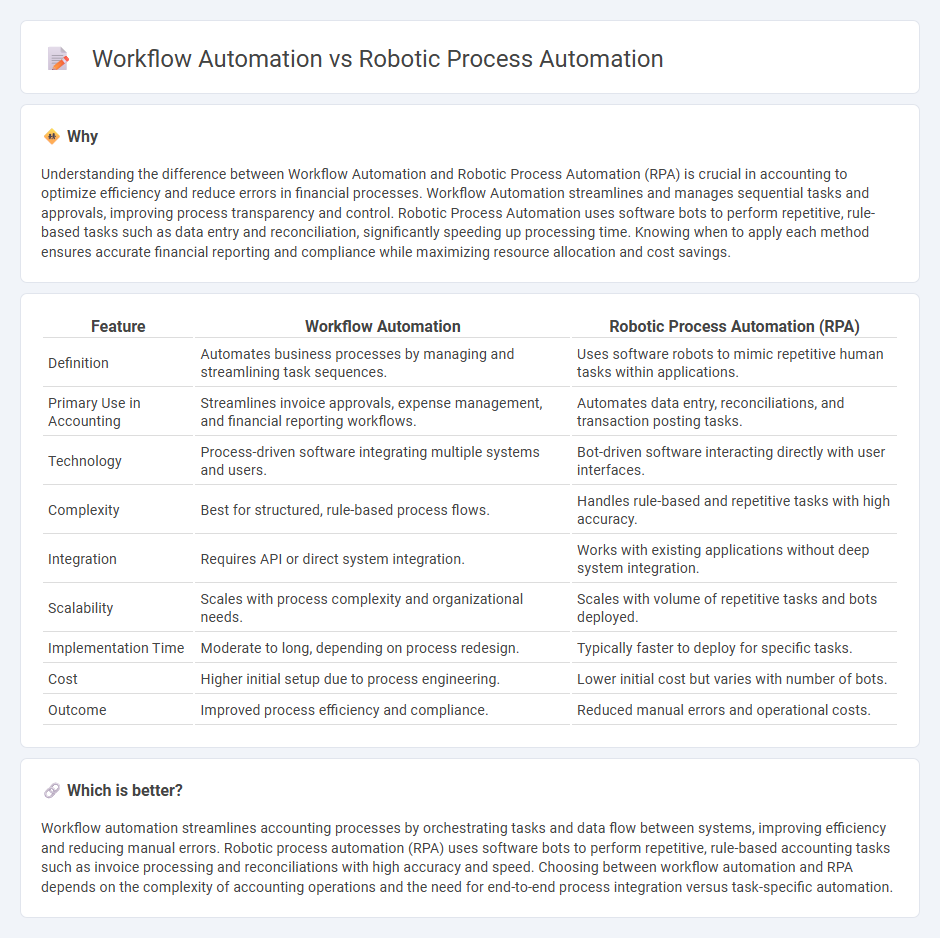
Workflow automation streamlines business processes by automating repetitive tasks through predefined sequences, enhancing efficiency in accounting operations such as invoice processing and financial reporting. Robotic process automation (RPA) employs software robots to mimic human actions, handling complex tasks like data extraction and reconciliation with greater accuracy. Discover more about how these technologies transform accounting workflows and improve financial management.
Why it is important
Understanding the difference between Workflow Automation and Robotic Process Automation (RPA) is crucial in accounting to optimize efficiency and reduce errors in financial processes. Workflow Automation streamlines and manages sequential tasks and approvals, improving process transparency and control. Robotic Process Automation uses software bots to perform repetitive, rule-based tasks such as data entry and reconciliation, significantly speeding up processing time. Knowing when to apply each method ensures accurate financial reporting and compliance while maximizing resource allocation and cost savings.
Comparison Table
| Feature | Workflow Automation | Robotic Process Automation (RPA) |
|---|---|---|
| Definition | Automates business processes by managing and streamlining task sequences. | Uses software robots to mimic repetitive human tasks within applications. |
| Primary Use in Accounting | Streamlines invoice approvals, expense management, and financial reporting workflows. | Automates data entry, reconciliations, and transaction posting tasks. |
| Technology | Process-driven software integrating multiple systems and users. | Bot-driven software interacting directly with user interfaces. |
| Complexity | Best for structured, rule-based process flows. | Handles rule-based and repetitive tasks with high accuracy. |
| Integration | Requires API or direct system integration. | Works with existing applications without deep system integration. |
| Scalability | Scales with process complexity and organizational needs. | Scales with volume of repetitive tasks and bots deployed. |
| Implementation Time | Moderate to long, depending on process redesign. | Typically faster to deploy for specific tasks. |
| Cost | Higher initial setup due to process engineering. | Lower initial cost but varies with number of bots. |
| Outcome | Improved process efficiency and compliance. | Reduced manual errors and operational costs. |
Which is better?
Workflow automation streamlines accounting processes by orchestrating tasks and data flow between systems, improving efficiency and reducing manual errors. Robotic process automation (RPA) uses software bots to perform repetitive, rule-based accounting tasks such as invoice processing and reconciliations with high accuracy and speed. Choosing between workflow automation and RPA depends on the complexity of accounting operations and the need for end-to-end process integration versus task-specific automation.
Connection
Workflow automation and Robotic Process Automation (RPA) are interconnected technologies that streamline accounting processes by reducing manual tasks and improving accuracy. Workflow automation structures and manages accounting tasks through predefined sequences, while RPA executes repetitive actions such as data entry and reconciliation within these workflows. Integrating RPA into workflow automation enhances operational efficiency, accelerates financial reporting, and minimizes errors in accounting departments.
Key Terms
Task Automation
Robotic Process Automation (RPA) employs software robots to mimic human actions and automate repetitive tasks across applications, enhancing accuracy and efficiency in task automation. Workflow Automation structures and streamlines end-to-end business processes by integrating systems and data flows, optimizing task sequences and improving operational visibility. Explore detailed insights to understand which automation technology best suits your task optimization needs.
Process Integration
Robotic process automation (RPA) excels at automating repetitive, rule-based tasks by mimicking human actions across multiple applications, enabling seamless process integration without altering existing systems. In contrast, workflow automation streamlines structured business processes by coordinating tasks and approvals within predefined workflows, facilitating end-to-end process management. Discover how integrating RPA with workflow automation optimizes operational efficiency and drives digital transformation.
Exception Handling
Robotic Process Automation (RPA) excels in handling exceptions by mimicking human intervention when unexpected scenarios arise, enabling dynamic decision-making within complex tasks. Workflow automation typically relies on predefined rules and linear processes, which may struggle with unplanned exceptions without manual input. Explore how integrating advanced exception handling can enhance both RPA and workflow automation effectiveness for your business operations.
Source and External Links
What is Robotic Process Automation (RPA)? - RPA is business process automation technology using software robots to automate repetitive human tasks, integrating with various applications by mimicking user interactions and combining with AI for intelligent automation.
What is Robotic Process Automation - RPA Software - RPA software builds, deploys, and manages software robots that automate workflows, reduce errors and costs, and free employees from mundane tasks, accelerating digital transformation across enterprises.
Robotic Process Automation (RPA) - RPA uses bots to automate repetitive, standardized tasks across industries, improving workflow efficiency in areas like document processing, invoice handling, customer service, HR, and supply chain management.
 dowidth.com
dowidth.com